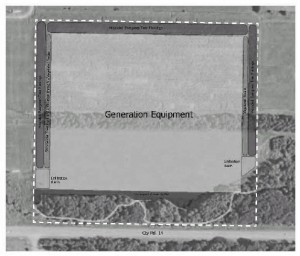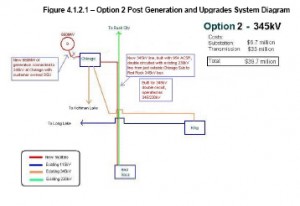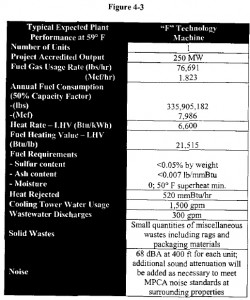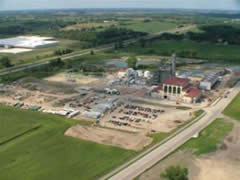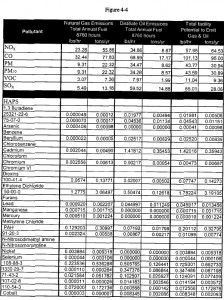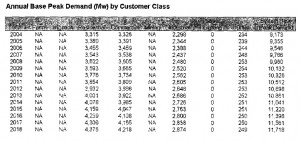500+ give LS Power a piece of their mind
October 20th, 2009
XCEL DOESN’T NEED OR WANT MORE ELECTRICITY, XCEL DOESN’T WANT A POWER PURCHASE AGREEMENT WITH LS POWER, SUNRISE ENERGY, OR WHOEVER…
That was the most important thing to come out of last night’s meeting. Mikey Bull was clear, stating in a most Norwegian way that “despite what Carol thinks, our load is growing,” and that they “won’t have a need… until 2016 or 2017.” I hope that people LISTENED CAREFULLY and were thinking critically.
Shellene Johnson, CRVC, walked Bob Cupit through the siting review and permitting options:
Bob was thrilled, I’m sure, he thought I’d put her up to it, but hey, I’m innocent — this is info that needs to be public, so that people understand all the options. Shellene had questions, particularly where this was an issue that had come up way back when we worked on the County Essential Services ordinance, and wanted to beef up the county’s ordinance to give them some options if a project went through local review. Local review is NOT a new issue for Chisago County, and if you recall, the SE Metro line went through the local review process.
Alan Muller was his usual delightful self, leading Blake Wheatley through a list of questions that demonstrated the “vaporware” nature of this project — he couldn’t or wouldn’t give us any information at all about the project. He knew NOTINK!
What would be the output of this plant? Answer:
780 MW summer rating. Over 800 winter rating. [Gas turbines
make more power when the air is colder and more dense.]How many generating units would there
be?
Answer: Don’t
know/haven’t decided.Who would be the manufacturer of the combustion
turbines? Answer:
Don’t know/haven’t decided.Who would be the manufacturer of the steam
turbines? Answer: Don’t
know/haven’t decided.How many smokestacks would the plant have?
Answer: Don’t know/haven’t
decided.How gallons or barrels of oil would be stored on the
site:
Answer: Don’t know/haven’t decided.How much oil would be burned in a
year?
Answer: Don’t
know/haven’t decided.In your air permit application, how many pounds per year of regulated air
pollutants would you be asking permission to put up your
smokestacks? Answer: Don’t know/haven’t
decided.And so on …..
…he knew nothing at all about this, and that’s because there’s nothing to know. There’s no project plan, no Power Purchase Agreement, no state permit applications, nada… This isn’t a project, it’s a farce… Tom Micheletti could take lessons from Blake Wheatley. Here’s the site plan, from the Oct 15 2009 Revised Draft Development Agreement:
WOW, that says a lot…
Take the time to read these:
Oct 15 2009 Revised Draft Development Agreement
I promised to post a few things so people can learn about prior proposals to get an idea what this one means, so let’s do that. Bear with me, this is interesting stuff!
This MISO Interconnection study says that for 660MW of generation at the Chisago sub, lots of transmission would need to be added. Here’s what one of the two similar options looks like (it’s better in print than here, looks hard to read):
Next is an answer to “what exactly are they proposing” with a couple of prior applications for gas plants as examples of what to expect, what to look for:
Faribault Energy Park – Application
These two applications are important to see what gas plants are all about. For example, the Faribault Energy Park is a 250MW plant, and here are some fun facts from the application:
A 250MW plant is 68 dB(A) 400 feet from the plant… what will a plant three+ times that be?
Here’s what that plant looks like – REMEMBER 750MW IS THREE TIMES THE SIZE OF A 250MW PLANT AND 855MW IS NEARLY FOUR TIMES AS LARGE:
Here’s a closer side view:
Here’s an emissions chart, and remember, the LS Power proposal is 3+ times this, so expect over three times the emissions:
And here’s a fun fact, from the 2004 Blue Lake application, showing their projected “need” back in 2004 that’s WAY overestimated:
From Xcel’s 2008 10-k, p. 10:
Capacity and Demand
Uninterrupted system peak demand for the NSP System’s electric utility for each of the last three years and the forecast for 2009, assuming normal weather, is listed below.System Peak Demand (in MW)
2006 2007 2008 2009 Forecast
9,859 9,427 8,697 9,662The peak demand for the NSP System typically occurs in the summer. The 2008 system peak demand for the NSP System occurred on July 29, 2008.
And now we know that instead of inexplicably going up in 2009, it’s going down. DOWN, further down. But note that in their 2008 10-k, Xcel admits that system peak was 8.697, lower than 2004. That pushes out any need until when? And the longer this drop continues, the further out and less probably any increased need is! And remember, Blue Lake was added to address the 11,000MW need claimed in the application. To get beyond that, how long will it take? With conservation, probably forever, we’ll never need more!
So, folks, as you can see, this isn’t rocket science, and they have no plan, no Power Purchase Agreement, it isn’t needed, it isn’t wanted. LS Power, go away.
CRVC intervenes – LS Power Sunrise River Energy plant
October 13th, 2009
.
Yes, and it’s about time — Concerned River Valley Citizens, who fought the Chisago Transmission Project for over a decade, have intervened in the Lent Township and Chisago County proceedings about this project.
Lent Township and Chisago County are negotiating a “development agreement” and as it comes together, WITHOUT PUBLIC INPUT, a lot of important issues are being decided that these local governments have no business or authority to decide without public input. Lighting is within a township’s zoning jurisdiction, but light pollution, which will certainly be an issue, is also an issue for the PUC. Noise is an issue for the ownship, but it is also under jurisdiction (with too loose standards) of the MPCA. There will be an air permit, and I sure hope that puts limits on fuel oil use. Any development agreement presumes that the plant will be built, and that’s not a presumption CRVC is comfortable with.
There are too many unanswered questions. Where is the need for this plant? Xcel’s not about to be buying any electricity from them anytime soon, and LS Power was shown the door. What is proposed? LS Power can’t/won’t even tell state regulators with any specificity, and they’ve been told go away until they’ve got something solid.
What are they proposing? Hard to tell… there’s no application to the PUC yet, which is another reason all this “pre-application” dealing with local governments is a problem. They’re doing deals with local governments before it’s at all clear what’s proposed, and without knowing what’s proposed, so how can any agreements be made? Who in the township or county has any experience with big natural gas plants and associated infrastructure like gas pipelines, water pipelines, transmission… well, some in Chisago County have a lot of transmission expertise! We do know some things from public documents, i.e., the MISO interconnection queue documents say 855MW gas with fuel oil back up, the legislation passed, again, without public notice or input, specifies no more than 780MW Summer Capacity, and a recent LS Power presentation:
The problem is that the local governments are making agreements, which include concessions and plans, without public input, and by making these agreements, they implicitly approve this project, with some conditions, which means that LS Power can move this project towards reality without the input necessary to thoroughly vet the application. Who is Chisago County to make an agreement regarding water use when it’s also an issue within DNR jurisdiction? They tried to pass the utility personal property tax exemption legislation without even letting local governments know the revenue impacts and how utility personal property tax Host Fee Agreements work, or that they even exist… so the question — who is protecting the public interest in all of these agreements? Hence the CRVC intervention.
And just for the record, in one of the articles they quoted an LS Power rep as saying the only emission is steam. WHAT??!!!??? Let’s see what your air permit application says… duh… let’s have a look at NOx… How stupid do they think we are? STEAM?!?!? Yeah, like the Prairie Island plant is a “steam plant.”
Here’s CRVC’s Lent Township Intervention:
Exhibit B – MISO Transition – Fasibility Analysis Posting G901-G999Exhibit C – June 16 Lent Township Board of Supervisors Meeting Minutes
Exhibit C – June 16 Lent Township Board of Supervisors Meeting Minutes
Exhibit D – July 30 – Hundreds attend meeting to learn about power plant
Exhibit E – February 17 Lent Township Board of Supervisors Meeting
Exhibit F – May 19 Lent Township Board of Supervisors Meeting
Exhibit G – April 21 Lent Township Board of Supervisors Meeting
Exhibit H – July 21 Lent Township Board of Supervisors Meeting
Exhibit I – August 18 Lent Township Board of Supervisors Meeting
And here’s CRVC’s Chisago County Intervention:
Exhibit A – MISO G135 Feasibility Study
Exhibit B – MISO Transition – Feasibility Analysis Posting G901-999
Exhibit C – April 15 Official Proceedings
Exhibit D – County Attorney Correspondence
Exhibit E – Memo Chisago Co Environmental Services & Zoning
Exhibit F – Letter – Sunrise River June 30
Exhibit G – National Park Service Letter July 29
Exhibit H – Chisago Co Water Plan Policy Team Minutes August 10
Exhibit I – Technical Memo – Barr Engineering – Test Well 1 Geology and Well Summary
Exhibit J – Water Team Recommendation of EIS August 11
Exhibit K – Chisago Co Board Minutes August 19

